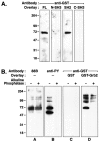Tyrosine phosphorylation of nicotinic acetylcholine receptor mediates Grb2 binding
- PMID: 9185541
- PMCID: PMC6573310
- DOI: 10.1523/JNEUROSCI.17-13-05038.1997
Tyrosine phosphorylation of nicotinic acetylcholine receptor mediates Grb2 binding
Abstract
Tyrosine phosphorylation of the nicotinic acetylcholine receptor (AChR) is associated with an altered rate of receptor desensitization and also may play a role in agrin-induced receptor clustering. We have demonstrated a previously unsuspected interaction between Torpedo AChR and the adaptor protein Grb2. The binding is mediated by the Src homology 2 (SH2) domain of Grb2 and the tyrosine-phosphorylated delta subunit of the AChR. Dephosphorylation of the delta subunit abolishes Grb2 binding. A cytoplasmic domain of the delta subunit contains a binding motif (pYXNX) for the SH2 domain of Grb2. Indeed, a phosphopeptide corresponding to this region of the delta subunit binds to Grb2 SH2 fusion proteins with relatively high affinity, whereas a peptide lacking phosphorylation on tyrosine exhibits no binding. Grb2 is colocalized with the AChR on the innervated face of Torpedo electrocytes. Furthermore, Grb2 specifically copurifies with AChR solubilized from postsynaptic membranes. These data suggest a novel role for tyrosine phosphorylation of the AChR in the initiation of a Grb2-mediated signaling cascade at the postsynaptic membrane.
Figures






Similar articles
-
Developmental regulation of tyrosine phosphorylation of the nicotinic acetylcholine receptor in Torpedo electrocyte.Mol Cell Neurosci. 1999 Jan;13(1):69-78. doi: 10.1006/mcne.1998.0728. Mol Cell Neurosci. 1999. PMID: 10049532
-
Phosphorylation of the nicotinic acetylcholine receptor by protein tyrosine kinases.Ann N Y Acad Sci. 1995 May 10;757:197-214. doi: 10.1111/j.1749-6632.1995.tb17476.x. Ann N Y Acad Sci. 1995. PMID: 7541972 Review.
-
Binding of the nicotinic acetylcholine receptor to SH2 domains of Fyn and Fyk protein tyrosine kinases.J Biol Chem. 1994 Nov 25;269(47):29817-24. J Biol Chem. 1994. PMID: 7961974
-
A conserved amino-terminal Shc domain binds to phosphotyrosine motifs in activated receptors and phosphopeptides.Curr Biol. 1995 Apr 1;5(4):404-12. doi: 10.1016/s0960-9822(95)00081-9. Curr Biol. 1995. PMID: 7542991
-
Involvement of proline-rich tyrosine kinase 2 in platelet activation: tyrosine phosphorylation mostly dependent on alphaIIbbeta3 integrin and protein kinase C, translocation to the cytoskeleton and association with Shc through Grb2.Biochem J. 2000 Apr 15;347(Pt 2):561-9. doi: 10.1042/0264-6021:3470561. Biochem J. 2000. PMID: 10749687 Free PMC article.
Cited by
-
Structural answers and persistent questions about how nicotinic receptors work.Front Biosci. 2008 May 1;13:5479-510. doi: 10.2741/3094. Front Biosci. 2008. PMID: 18508600 Free PMC article. Review.
-
Proteomic analysis of an alpha7 nicotinic acetylcholine receptor interactome.J Proteome Res. 2009 Apr;8(4):1849-58. doi: 10.1021/pr800731z. J Proteome Res. 2009. PMID: 19714875 Free PMC article.
-
Roles of nicotinic acetylcholine receptor β subunit cytoplasmic loops in acute desensitization and single-channel features.Neuroscience. 2015 Mar 19;289:315-23. doi: 10.1016/j.neuroscience.2014.12.016. Epub 2014 Dec 20. Neuroscience. 2015. PMID: 25536046 Free PMC article.
-
The actin-driven movement and formation of acetylcholine receptor clusters.J Cell Biol. 2000 Sep 18;150(6):1321-34. doi: 10.1083/jcb.150.6.1321. J Cell Biol. 2000. PMID: 10995438 Free PMC article.
-
Growth factor-mediated Fyn signaling regulates alpha-amino-3- hydroxy-5-methyl-4-isoxazolepropionic acid (AMPA) receptor expression in rodent neocortical neurons.Proc Natl Acad Sci U S A. 1999 Mar 2;96(5):2461-6. doi: 10.1073/pnas.96.5.2461. Proc Natl Acad Sci U S A. 1999. PMID: 10051665 Free PMC article.
References
-
- Blaikie P, Immanuel D, Wu J, Li N, Yajnik V, Margolis B. A region in Shc distinct from the SH2 domain can bind tyrosine-phosphorylated growth factor receptors. J Biol Chem. 1994;269:32031–32034. - PubMed
-
- Bowe MA, Deyst KA, Leszyk JD, Fallon JR. Identification and purification of an agrin receptor from Torpedo postsynaptic membranes: a heteromeric complex related to the dystroglycans. Neuron. 1994;12:1173–1180. - PubMed
-
- Campanelli JT, Roberds SL, Campbell KP, Scheller RH. A role for dystrophin-associated glycoproteins and utrophin in agrin-induced AChR clustering. Cell. 1994;77:663–674. - PubMed
-
- Chardin P, Cussac D, Maignan S, Ducruix A. The Grb2 adaptor. FEBS Lett. 1995;369:47–51. - PubMed
Publication types
MeSH terms
Substances
LinkOut - more resources
Full Text Sources
Other Literature Sources
Research Materials
Miscellaneous
